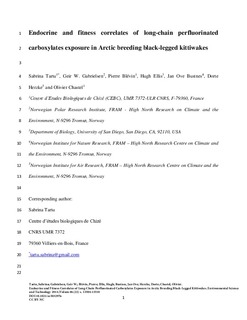| dc.contributor.author | Tartu, Sabrina | |
| dc.contributor.author | Gabrielsen, Geir W. | |
| dc.contributor.author | Blévin, Pierre | |
| dc.contributor.author | Ellis, Hugh | |
| dc.contributor.author | Bustnes, Jan Ove | |
| dc.contributor.author | Herzke, Dorte | |
| dc.contributor.author | Chastel, Olivier | |
| dc.date.accessioned | 2018-01-23T13:32:21Z | |
| dc.date.available | 2018-01-23T13:32:21Z | |
| dc.date.created | 2014-11-10T13:10:31Z | |
| dc.date.issued | 2014 | |
| dc.identifier.citation | Environmental Science and Technology. 2014, 48 (22), 13504-13510. | nb_NO |
| dc.identifier.issn | 0013-936X | |
| dc.identifier.uri | http://hdl.handle.net/11250/2479115 | |
| dc.description.abstract | Increasing levels of poly- and perfluorinated alkyl substances (PFASs) have recently been described in Arctic biota. These emerging substances are of concern given their resistance to degradation and metabolization. Some studies have reported endocrine disrupting effects for some PFASs. However, there is a gap of knowledge on the potential relationships between PFASs and hormones mediating the life-history trade-off between reproduction and survival, such as glucocorticoids. The aims of this study were to (1) describe the concentrations of plasma perfluoroalkyl sulfonates and perfluoroalkyl carboxylates in Svalbard black-legged kittiwakes (Rissa tridactyla) in relation to gender and body-condition, (2) explore the relationships between PFASs and corticosterone (the major glucocorticoid in birds), and (3) assess the consequences of PFAS exposure for reproductive success. Perfluorononanoate was positively related to body-condition in male kittiwakes; perfluorotridecanoate and perfluorotetradecanoate to decreased baseline corticosterone in both sexes; and perfluorododecanoate was related to lower hatching success. These results underline the importance of considering each compound separately when investigating the hazardous effects of PFASs on wildlife. | nb_NO |
| dc.language.iso | eng | nb_NO |
| dc.rights | Attribution-NonCommercial-NoDerivatives 4.0 Internasjonal | * |
| dc.rights.uri | http://creativecommons.org/licenses/by-nc-nd/4.0/deed.no | * |
| dc.title | Endocrine and Fitness Correlates of Long-Chain Perfluorinated Carboxylates Exposure in Arctic Breeding Black-Legged Kittiwakes | nb_NO |
| dc.type | Journal article | nb_NO |
| dc.type | Peer reviewed | nb_NO |
| dc.description.version | acceptedVersion | nb_NO |
| dc.source.pagenumber | 13504-13510 | nb_NO |
| dc.source.volume | 48 | nb_NO |
| dc.source.journal | Environmental Science and Technology | nb_NO |
| dc.source.issue | 22 | nb_NO |
| dc.identifier.doi | 10.1021/es503297n | |
| dc.identifier.cristin | 1171553 | |
| dc.relation.project | Norges forskningsråd: 176073 | nb_NO |
| dc.relation.project | Norges forskningsråd: 234423 | nb_NO |
| cristin.unitcode | 7511,4,0,0 | |
| cristin.unitname | Tromsø | |
| cristin.ispublished | true | |
| cristin.fulltext | postprint | |
| cristin.qualitycode | 2 | |

